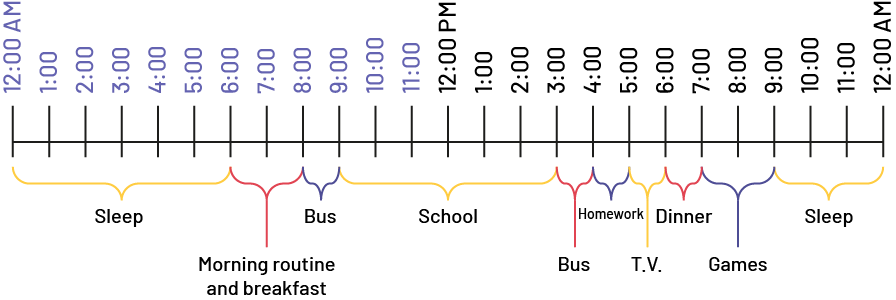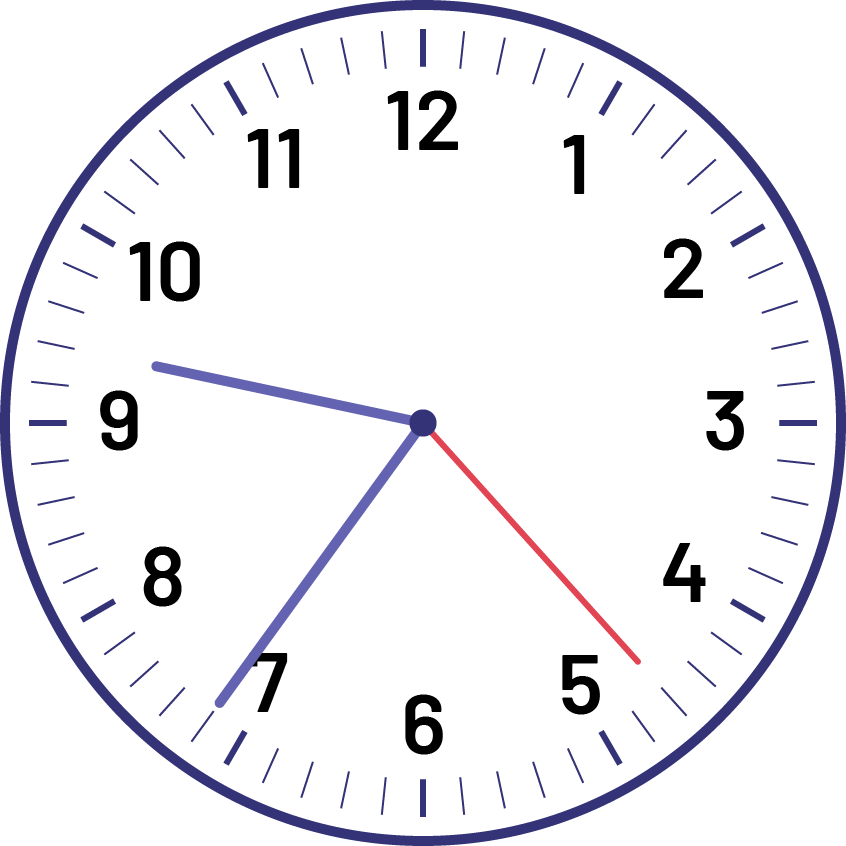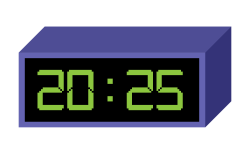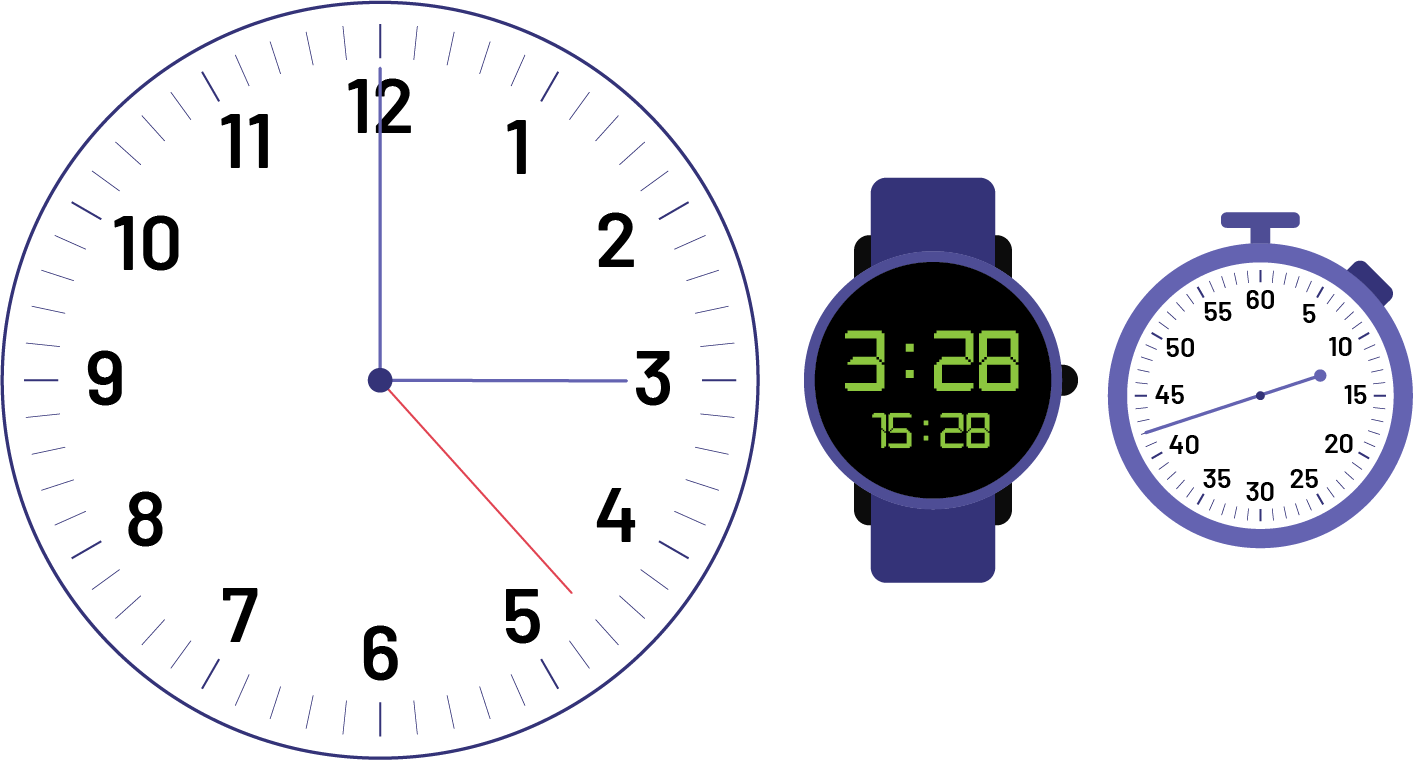E2.6 Use analog and digital clocks and timers to tell time in hours, minutes, and seconds.
Skill: Telling Time in Hours, Minutes, and Seconds Using Analog and Digital Clocks and Timers
Learning to read time on an analog or digital clock should be done in relation to daily activities.
Teachers should identify key times of the day at school and at home and incorporate them into a time-reading activity (for example, wake-up time, start of school, recess, and bedtime).
A 12-hour timeline allows students to become familiar with reading the time on an analog clock (12-hour display).
The measurements can become more and more precise on this timeline depending on the intention. Measurements can become more and more precise on this timeline in order to establish the relationship between the 12-hour display and the 24-hour display.
 Image A timeline that represents the 24 hours of a day. midnight to 6 am: sleep; 6 to 8 a.m., personal grooming and lunch; 8 to 9, take the bus; 9 to 3, school; 3 to 4, bus; 4 to 5, homework 5 to 6, TV; 6 to 7, supper; 7-9 , playtime; 9 to midnight, sleep.
Image A timeline that represents the 24 hours of a day. midnight to 6 am: sleep; 6 to 8 a.m., personal grooming and lunch; 8 to 9, take the bus; 9 to 3, school; 3 to 4, bus; 4 to 5, homework 5 to 6, TV; 6 to 7, supper; 7-9 , playtime; 9 to midnight, sleep.
To read an analog clock correctly, you need to understand that:

- the hands of the clock turn to the right;
- the small hand indicates the hour;
- that the circumference of the clock is graduated with small lines in multiples of 5;
- the large hand indicates minutes (for example, since the large hand points to the first line after the number 7, it is 1 minute more than 7 multiples of 5 minutes, namely 36 minutes);
- the third hand indicates seconds (for example, 23 seconds).
To properly read a digital clock, you need to understand that:

- the number to the left of the colon indicates the hour and the number to the right of the colon indicates the minutes (for example, 8:25 p.m.);
- the clock could indicate the time in either a 12-hour or 24-hour display.
Source: translated from Guide d’enseignement efficace des mathématiques, de la maternelle à la 3e année, Mesure, p. 65-66; p. 95-96.
In English, there are established conventions for writing time. Whether the 24- or 12-hour clock is being used, the time symbol is represented with a colon (namely, thirty minutes after nine o'clock at night can be written 21:30, 21:30:00 or 9:30 p.m.). The first half of the day (from midnight until noon) uses the abbreviation a.m. (for “ante meridiem” or before midday) and the second half of the day (from noon to midnight) uses the abbreviation p.m. (for “post meridiem” or after midday”).
Numbers can be written according to the 24-hour division of the day for maximum clarity (for example, 20:45, as opposed to 8:45 p.m.).
If the time is given to the nearest hour, zeros are added for the minutes (for example, 11:00 a.m.).
The 24-hour notation is shorter, removes the potential for confusing the first and second halves of the day especially visible at midnight and noon.
Noon is written as 12 p.m. Midnight is written either as 24:00 to indicate the end of a day, or as 12 a.m. or 0:00 to indicate the start of a day. Thus, fifteen minutes after midnight can be written as 12: 15 a.m. or 0:15.
The time to the nearest second is written as 9:36:23.
Source: translated from Guide d’enseignement efficace des mathématiques, de la maternelle à la 3e année, Mesure, p. 47, 101.
Knowledge: Attribute Time
Time is an attribute that can be used to designate two different characteristics of a situation or an event: a precise moment or a duration.
- Time as a precise instant means the time it is when an event takes place. It is an attribute that can be read, for example, on a watch or a clock.
- Time as duration refers to the time interval between two moments of an event and is an attribute that can be measured, for example, with a stopwatch.
A clock answers two questions, ”What time is it?“ and ”How much time has passed?“
In Grade 3, the focus is on the first question.
The 24-hour clock is widely used in transportation schedules and in the military. For many parts of the world, as well as in the French language, it is the standard way of describing time.
Source: The Ontario Curriculum. Mathematics, Grades 1-8 Ontario Ministry of Education, 2020.
Knowledge: Analog and Digital Clocks and Timers
Examples

Source: translated from Fiche attribut Temps, Mat-3e.
On a digital clock, the time is easier to read, but can be more difficult to understand. To know that at 9:58 a.m. it is almost 10:00 a.m., you have to understand that there are 60 minutes in an hour. This differs from the place value system, which is a base ten system. Using both a digital and an analog clock makes it easier to see the scale from 0 to 60.
Source: The Ontario Curriculum. Mathematics, Grades 1-8 Ontario Ministry of Education, 2020.
